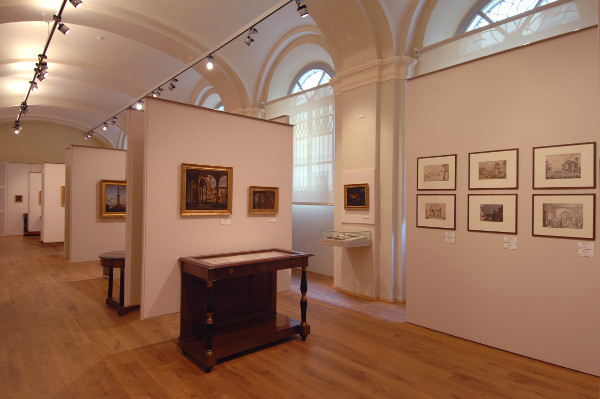


In the rooms of the exhibition venue, a historic building in the city, works from various eras illustrating the vibrancy of Alexandria and its territory are preserved and presented in the exhibition: portraits of the personalities and depictions of the historical and cultural moments that animated it. In the first room, "The Rooms of Arthur and the Image of the Alexandrian Middle Ages," one can admire wall frescoes dating back to the late 13th century, one of the earliest-probably the oldest preserved today-figurative depictions of the legend of King Arthur and the Knights of the Round Table.

The 15 frescoed scenes were found in 1971 at the Cascina Torre in Frugarolo, a Carolingian curtis, later a castrum and mansio with hospitium of the Knights Hierosolimitani, later a stately residence and, in modern times, a farmstead that fell into disuse in the second half of the 20th century. A work commissioned at the end of the 14th century by Andreino Trotti, a condottiere and member of a prominent Alexandrian family, to celebrate the victory he, alongside Gian Galeazzo Visconti, had achieved against French troops in 1391, the frescoes were painted after this date and before 1402, curiously enough the year of the death of both Galeazzo Visconti and Alessandro Trotti. They were executed by artists from the Visconti workshops in Pavia, who were inspired by images from illuminated codices of the stories of Lancelot and Arthur: one of the oldest specimens of the medieval "classic" Lanzaloti room, rooms decorated with scenes depicting the famous legend of King Arthur and the Knights of the Round Table, the Alexandrian pictorial cycle constitutes an important testimony to the spread in Italy of the Arthurian saga and the famous cornerstone novel of literature on the theme, the Lancelot du Lac composed by the Burgundian troubadour Chretien De Troyes (c. 1135-before 1190) active in feudal courts in Brittany and England.

In the Alexandria Art Rooms, frescoes are displayed alongside artifacts and panels illustrating the history of Alexandria. Rising on May 3, 1168 near the Roman Forum Fluvii, the urban settlement takes its name from its founder, Pope Alexander III, who was an ally of the municipalities united in the Lombard League against Emperor Frederick Barbarossa and his vassals, particularly the Marquises of Monferrato, who besieged the newly built center from October 1174 to April 1175. An attack to which Alexandria did not succumb, and in an imperial document of 1184 it is mentioned as the city of the population formed de tribus locis, Gamunde vicelicet et Meringin et Burgul, respectively the inhabitants in Gamondium (Gamondio), Marenghum (Marengo) and Bergolium (Bergoglio - in the 11th-12th century miniature depicted to the right of the Tanaro, the river that runs through Alexandria).
 A section of the Alexandria Art Rooms is dedicated to the figure of Alexandrian artist Giovanni Migliara (1785-1837), with an exhibition of works and information panels illustrating the themes tackled by the painter and, thus, forming an educational itinerary that shows the typical nineteenth-century painting of genre and landscape views. The twentieth century is represented and refined by the paintings of Alberto Caffassi (1894-1973). In addition, a section of the city museum is dedicated to temporary exhibitions, monographs of local artists and thematic reviews.
A section of the Alexandria Art Rooms is dedicated to the figure of Alexandrian artist Giovanni Migliara (1785-1837), with an exhibition of works and information panels illustrating the themes tackled by the painter and, thus, forming an educational itinerary that shows the typical nineteenth-century painting of genre and landscape views. The twentieth century is represented and refined by the paintings of Alberto Caffassi (1894-1973). In addition, a section of the city museum is dedicated to temporary exhibitions, monographs of local artists and thematic reviews.
Sale d'Arte
Address: Via Niccolò Machiavelli, 13, 15100
Phone: +39 0131 234266
Site:
http://www.alexala.it/it/risorsa/sale-darte-comunali-di-alessandria/2efe58c59355a7ae2116ecbb2be1b183/011dd8617cd34213dc8760b2e84fef4/05d9f18840a5bdf9745a022db865ac1a/Location inserted by
Maddalena Monferrato HospitalityHandmade